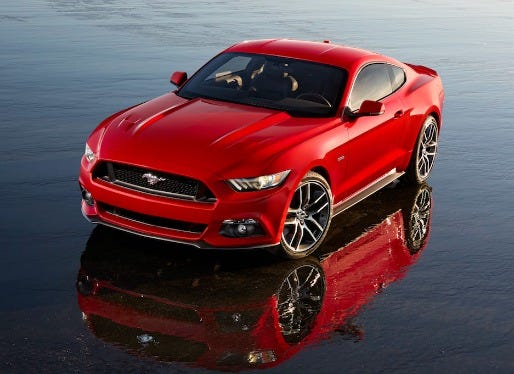Mustang — The First 50 Years

By the time I was old enough to start appreciating cars, the original generation of Ford Mustangs — 1965-73 — were already considered old cars. The restoration craze hadn't quite taken off yet, so a lot of "pony cars" were simply aging rustbuckets still tooling around, often handed off to second, third or fourth owners.
I specifically remember riding in the back of our station wagon on a long family road trip and watching a 'Stang pass us by. It had a gray primer paint, not a few dents and rust spots, and an exhaust that sounded like a perturbed elephant with a leaky trunk. I was mesmerized.
"One day," I intoned to no one in particular, "I'm going to own one of those."
My parents, used to the wayward ramblings of a precocious 10-year-old, paid little attention beyond a scoff and a harrumph.
Now, when I'm cruising around in my Winter Blue 1969 fastback — a 351C-4V, for those to whom that means something — I often encounter former Mustang owners who tell me about the cars they used to drive and love. "Why'd you get rid of it?" is the question I always ask. None of them has ever given an answer that really satisfied me or, I think, themselves.
This year, Ford is celebrating the 50th birthday of the Mustang, along with the introduction of the sixth-generation 2015 iteration. To celebrate they've produced a video, "Mustang — The First 50 Years."
This is an enjoyable and illustrative journey through the conception, first production and astonishing evolution of perhaps America's most famous automobile. It includes plenty of history and stock footage of the cars, interviews with the surviving original engineers and Ford executives, and other stuff you'd expect.
But they also pepper it liberally with profiles of individual Mustang owners and their cars, specialty shops like Roush, museums, integral personalities like Lee Iaccoca and Carroll Shelby, and a whole lot of other material that form the integral backstory behind the car.
I appreciated this, since it's easy to tell the story of how an idea became a car, but much harder to say how that car became an icon. That "Mustang — The First 50 Years" does, with flair and not a little showmanship.
It's also not afraid to take a hard look at some of the dark days of the Mustang, such as the early 1990s when Ford seriously considered canceling the entire line. There is also the second generation from 1974-78 when the car rapidly shrank in horsepower and (many feel) styling charisma in response to the oil crisis.
Originally envisioned as a "secretary's car," the Mustang soon grew larger and beefier, eventually becoming known as one of the kings of the muscle car movement of the late 1960s and early '70s. Though the look of the car has changed much over the years, it nearly always retained the inimitable styling cues — long hood, short deck, recessed headlights, low roofline, tri-bar taillights — that instantly marked it as a Mustang.
In an age when so many makes and models of cars are virtually indistinguishable from another, people can still spot a Mustang a long way off.
A total of 2½ hours long, "Mustang — The First 50 Years" is part tribute, part hagiography and a little bit of gentle myth-busting. What a sweet ride down memory lane.
4 Yaps



